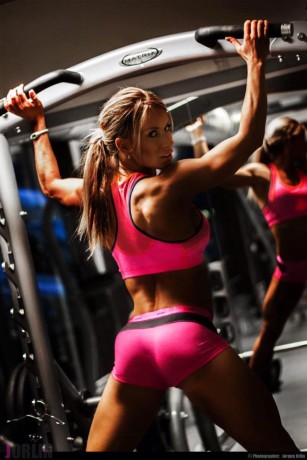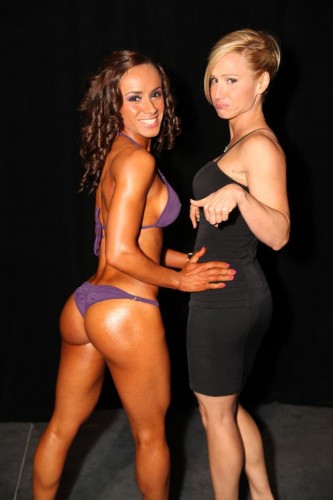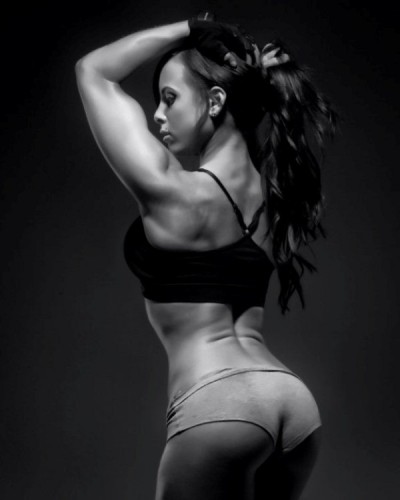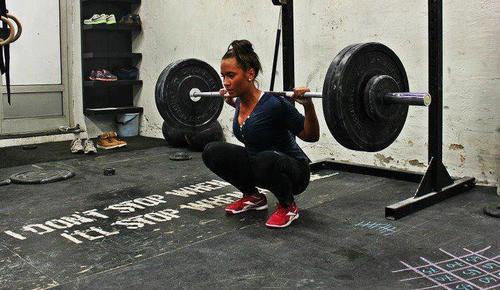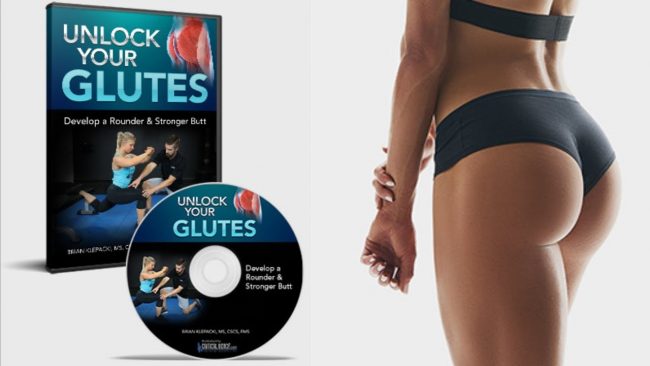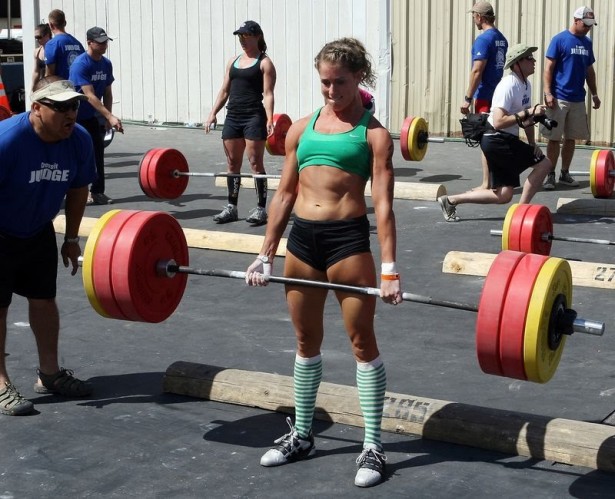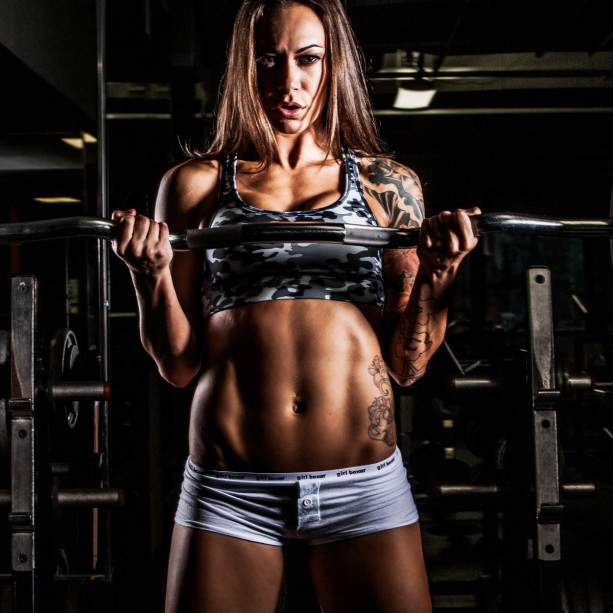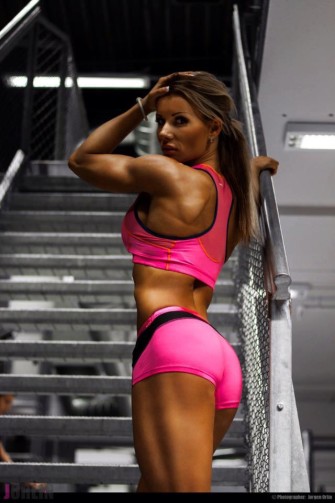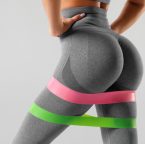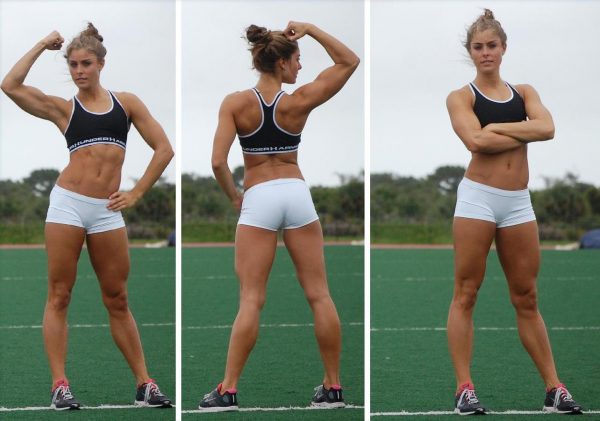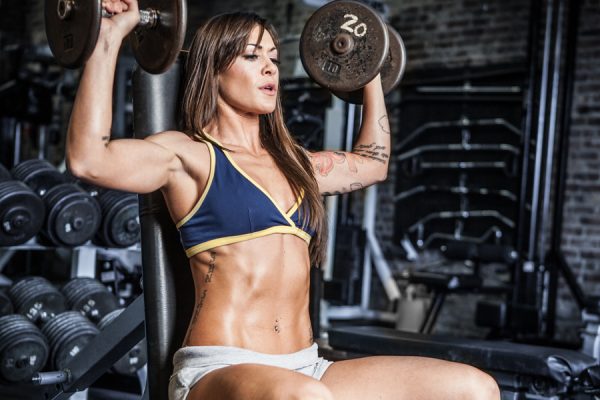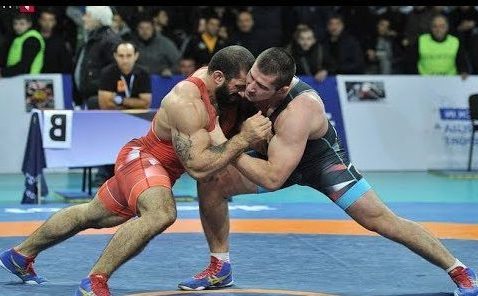There are no ifs, ands, or butts about it: even if you work your glutes regularly, what woman doesn’t want to make her rearview tighter, smaller, and sexier? Unfortunately, building the butt of your dreams is no easy task.
Women often store fat in their lower body, which means it’s generally the last place we lose extra weight.
Women also tend to want to cardio away to “get a butt” rather than put in the time under the iron, but as you’ll read, the clear path to a better booty isn’t going to be found on the treadmill or the elliptical, but on the gym floor, under a barbell.
Related: The Unlock Your Glutes Workout Program: For a Rounded and Stronger Butt
Related: How To Get A Round Booty: Exercises and Workout
It’s important to understand the muscles in the glutes before you can understand how to work them. The Gluteus Maximus is the largest and most superficial of the gluteal muscles and forms the bulk of the buttock mass.
The Gluteus Medius is largely covered by the gluteus maximus, and the Gluteus Minimus is the smallest and deepest of the gluteal muscles. Many muscles, such as the Iliocostalis Lumborum, Multifidus, and Quadratus Lumborum, Iliopsa also insert into and around the pelvis and play a role in how glutes “appear”, usually by contributing the positioning of the pelvic tilt, etc.
To shape the perfect glutes, you have to target your butt from many angles and there are a variety of exercises and activities that you can do to hit and develop each of the gluteal muscles for that desired perfection.
For example, the Gluteus Maximus is worked through the extension of the thigh; the Gluteus Medius is worked through adduction and lateral rotation of the thigh, and the Gluteus Minimus is worked the same as the gluteus medius.
I can personally attest that my posterior is built on a few solid exercises, most of which are old-school by today’s standards. There are no funky movements needed, no strange apparatus, and no expensive equipment.
You will not find me doing one-legged squats on a Bosu while touching my nose and holding a dumbbell overhead or any such nonsense.
I build my stage ready glutes using basic, simple, functional, and compound movements- exercises that offer the most bang for their buck.
The following are my personal five commandments for building a set of contest worthy glutes.
1) Thou shalt SQUAT
2) Thou shalt DEADLIFT
3) Thou shalt do SINGLE LEG WORK
4) Thou shalt PLYO
5) Thou shalt EAT CLEAN
Let’s go over each one in detail.
COMMANDMENT 1: Thou Shalt Squat
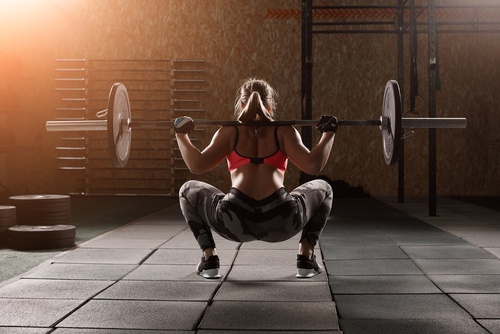
You want glutes you have to squat. There is no way around it. Properly executed squats shape the rear end in ways that simply cannot be achieved otherwise.
Properly executed squats target the hamstrings and glutes, and as with the deadlift (which I’ll mention in a moment) the stress of heavy squats also elicits a strong hormonal response which is key to metabolic disturbance and lipolysis.
If you walk into any commercial or “standard gym” you will see people “squatting” to parallel or higher. This is not a squat. I call this a half squat or a joke (assuming there isn’t a health issue preventing proper depth).
I CrossFit, and in the CrossFit world (although some boxes stress it less), I don’t have this problem. I perform SQUATS- real squats, the ideal depth being ASS TO GROUND or below parallel.
Basically, you want to squat until you cannot go down any further. The depth you can achieve may be limited to some extent by flexibility or physical handicap but always fight to get as low of a position as possible.
This is crucial because as well as hitting your quads, it’s going to develop strength in your glutes and hamstrings. This glute/hamstring development is shorted big time if you squat to parallel or above.
A little side note: if performed properly, there is nothing biomechanically wrong with a squat, so don’t let someone tell you squatting is horrible for your knees, etc.
According to Rob Faign of the NSCA, “there is a perverse situation prevailing in gyms across America: People are doing the right exercise (squats) the wrong way (half-way down) for the right reason (to protect their knees).”
So if you want to produce a good backend (aka glutes for days) learn to execute squats properly. A full squat (to parallel or below) is simply the most natural movement because it’s what we were DESIGNED to do. It’s getting up and sitting down. It’s getting in and out of a chair. It’s basic human function amplified.
Most people these days sit too much and move too little, and as a result, they lose the ability to generate muscle activation in the glutes/hamstrings/hip flexors and therefore lose mobility in their hip joint. They simply can’t squat properly, or within full ROM despite the fact that they were born to. I personally think that half squats are worse than a proper full squat because the point of highest force when the weight changes direction shears the knees rather than pushing the shin bone down into the floor.
Essentially it all boils down to the stress on the knee- and that’s what everyone argues about when discussing the squat. Knees are not really designed to bear a lot of weight at angles much beyond 90 degrees. So, as I said, if you have bad form AND your knees go over your toes you’re NOT doing your knees any good.
When squatting the knees should be tracking the feet the whole way. Keep your chest up and torso upright and work hard to prevent knees from bowing in as much as possible, which helps to put the weight BACK onto the heels and into the posterior chain. Push the knees OUT as you squat down and when you drive out of the hole, this will help activate the hips, hamstrings, and glutes more so then quads and knees.
There are so many variations of squats, so there is NO excuse not to. If you’re concerned about gaining size- do bodyweight squats or lightweight reps. If you’re new to squatting, work on perfecting your form FIRST and learn to get your butt down towards your heels before you go about getting beneath a barbell.
If you know you can perform a PROPER squat, get underneath some heavier weight 1-2x a week, working with heavy singles or sets of 3 and don’t rack up heavy sets of 5-10 if you want to keep it tiny, tight, and strong.
Related: Balanced Approach to Lower Body Training
COMMANDMENT 2: Thou Shalt Deadlift
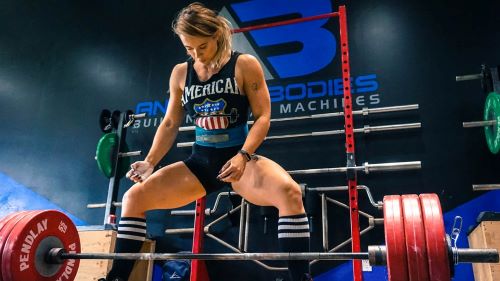
Any exercise with the word ‘dead’ in its title is bound to have a bad reputation. The Deadlift exists as an irony. Those who treat it like a sin are often the ones who need it the most.
If your back or knees are a mess, you’d better learn to pick things up correctly, and that is all a deadlift really is, proper lifting technique for anything. Deadlifts foster good posture and solid reliance on the posterior chain in doing work- think the glutes, hamstrings, and muscles in the back.
The remaining muscles are involved in stability control when you deadlift. I don’t think any seasoned gym veteran can dispute the effectiveness of deadlifts on the rear end. It’s incredibly important to “cue” the glutes when doing a deadlift- to think about the force-generating from your glutes and hamstrings and to execute by pushing back onto the heels.
It’s true, deadlifts don’t target the glutes as specifically as other movements, in fact, more of the hamstring comes into play then the glutes, but deadlifts are still a powerful force in building your back end. Although the common perception of this lift is of a giant bar being handled by some monster with no neck, let’s borrow the technique for the next time you pick up a book from the bottom shelf or lift your child, grab weight to put on your barbell, or bend over and want to have a sexy shape in your shorts. I often explain the deadlift as being the counterpart to the squat- think yin and yang. The squat is taught from bottom up and the deadlift is taught from top to bottom. The mechanics are very similar to a squat; in fact, they’re identical until you grab the bar.
The other GREAT thing about deadlifts is that there are so many varieties, each offering a unique way of targeting the back end. Extra-wide sumo deadlifts are an excellent exercise to strengthen the hamstrings, glutes, and hip abductors/adductors. Moving the stance out will really increase the stress on the hips and groin, two areas where many athletes are weak.
Trap bar deads are great for enhancing power, relieving lower back pain which can stem from straight bar deads, and are excellent for beginners because trap bar deads engage the hips more. The trap bar deadlift offers the benefits of both the squat and the regular deadlift in one exercise but without any of the negative aspects of the two conventional lifts.
Another great deadlift variety is Romanian Deadlifts or RDLS for short. RDLS are phenomenal for tightening up the backend, more so than most dead varieties. I’ve worked with tons of clients who were sick of glute kickbacks and donkey kicks and all sorts of glute funkiness in attempts to tighten the back end, only to add in RDLS and find things tightening up back there.
COMMANDMENT 3: Thou Shalt Do Single Leg Work
Many trainers, coaches, and therapists are quick to point out that unilateral training is superior to bilateral training in regards to improving asymmetries. Maybe yes, maybe no.
You can argue either for or against it. What I do believe is that a combination of single-leg work coupled with bilateral leg work is best. Some of the best lower bodywork for the glutes like walking lunges, Bulgarian split squats, pistols, and single-leg step-ups are performed unilaterally.
So make sure you add in some supplemental unilateral work to help increase midline stability, posture, and to really target those glute cheeks, one at a time.
The lunge may not be as sexy as a big squat or deadlift, but once you’ve learned to lunge effectively, or perform single-leg step-ups, or pistols (one-legged squats) you’ll quickly find that unilateral work is some of the most potent you can employ in your weight-training arsenal.
Try walking lunges, overhead lunges, step-ups (weighted or not), pistols, single leg RDLs, lateral step-ups, lateral lunges, short-stroke lunges, lunge jumps, and the good old stationary lunge.
RELATED: Get a Great Butt Without Doing Squats
COMMANDMENT 4: Thou Shalt Plyo
I have long been a huge fan of plyometrics, especially when it comes to shrinking, tightening and creating a solid set of hamstrings, quads, and glutes. The term “plyometrics” refers to an action in which a muscle is loaded eccentrically (lengthening), followed quickly by a concentric (shortening) muscle contraction. These drills allow your muscles to gain maximum exertion or force in the shortest amount of time. A good example is squat jumps or lunge jumps.
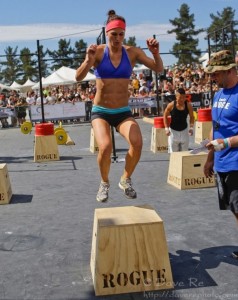
Studies have shown that plyo exercises increase blood flow to your leg muscles by 25%– increased blood flow helps power your metabolism and fuels working muscles. Quick explosive squats, for example, result in more muscle activity in your glutes than regular squats.
These explosive movements also engage more stabilizing muscles than your traditional cardio workout. Every time you land on the ground after a powerful leap, you not only get stronger but also you improve your rearview. Essentially you’re pounding that fat down and off and firming yourself up with some sexy lean posterior muscle. Plyometric intervals also increase your overall caloric burn and keep your metabolism burning for hours after your workout which is key to targeting fat loss not only in the glute region but total body.
Box Jumps, Squat Jumps, Tuck Jumps, Lateral One-Legged Hops, and Lunge Jumps are all great examples of lower body plyometrics that will help target your posterior. I’ve long said if you want to LOOK like an athlete, you need to train like one- which means you need to train for some explosive speed and strength and plyometrics are the way to go.
Related; 7 Best Glute Ham Raise Developers For Home Gyms
COMMANDMENT 5: Thou Shalt Eat Clean
The real battle, for most of you, when it comes to glutes is going to be what you do OUTSIDE of the gym. At the end of the day, what you choose to put in your mouth will either MAXIMIZE your gym efforts or DESTROY them. If you have physique goals, ANY physique goals, including a killer rear end, you need to become keenly aware of not just what you’re eating, but how much, and when.
Choose natural unprocessed foods first and foremost. Keep in mind the longer something remains eatable on your shelf the longer it will remain on your thighs. Strive to consume the majority of your calories from whole foods rather than shakes and bars.
Look for lean proteins like chicken breast, salmon, turkey breast, lean beef, and seafood, natural carbs in the forms of fruits and veggies, and healthy dietary fat from sources such as coconut oil, olive oil, raw nuts, seeds, and avocado. Keep processed foods, grains, soy, refined sugars, dairy, and diet products with artificial sweeteners in them to a minimum, if at all.
A really great workout I’ve done in the past which has left my glutes happily sore is to string together combinations of compound movements, like the squat and the deadlift with high-intensity plyos and some accessory work through standard set and rep training.
I tend to open up my lower body work with hip/mobility training to help prevent any injury. I highly recommend visiting Kelly Starrett’s Mobilitywod.com for more on mobility drills which can benefit the lower body.
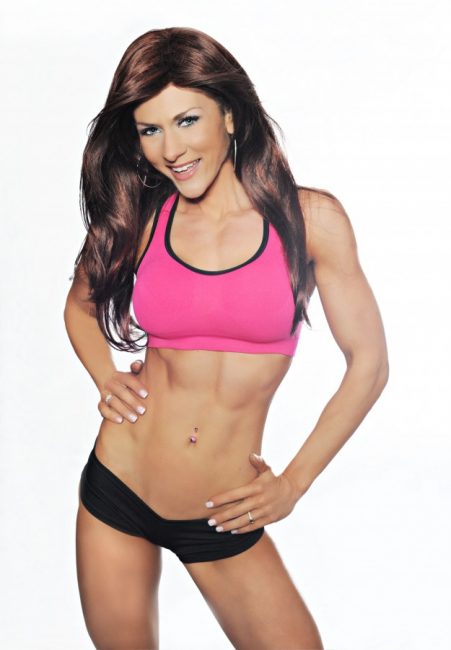
Allison Moyer-Fahrenbach is a nationally and internationally published fitness model, well known NPC figure competitor, CrossFit and strength athlete, entrepreneur, motivator, nutritionist and performance dietary specialist based out of Lancaster, PA. She holds a Bachelors in Wellness and Sports Science as well as multiple certifications including her C.P.T, C.S.N, C.S.C.C, and her CF-L1 and CF Weightlifting. She can be contacted for appearances, talks, seminars, posing classes, training and more through her website www.alli-fitness.com or by email, [email protected].

